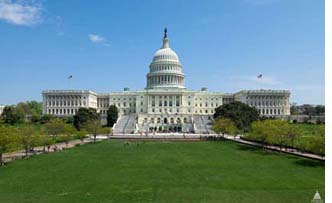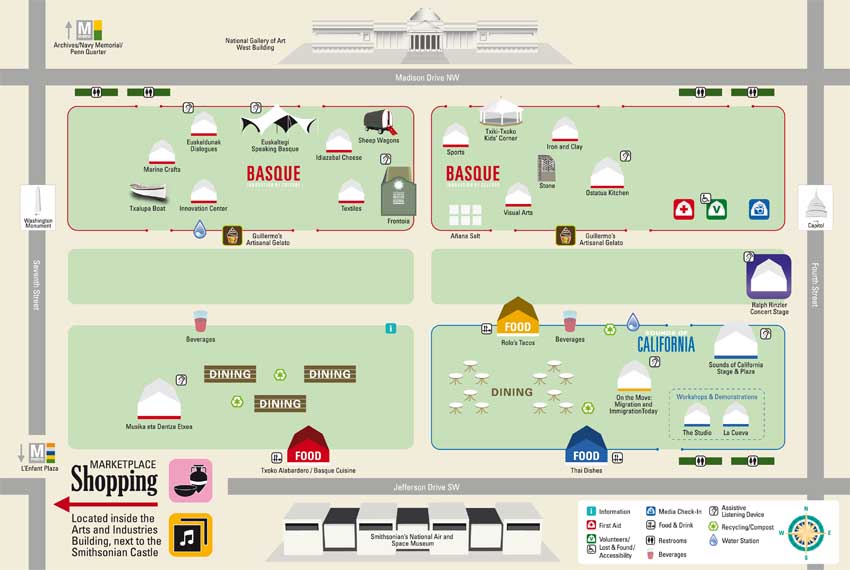Bilbao, Bizkaia/ Washington DC. In organizing the event the Smithsonian Institution has counted on the support of Basque institutions, specifically the Provincial Government of Bizkaia, as well as the Basque Government and also the Provincial Governments of Araba and Gipuzkoa, among other organizations (there will also be representation from Nafarroa and Iparralde). It is truly a unique opportunity and the culture of the Basque Country will not have for a long time an exceptional showcase like this one to present to the American public its past, present and future, leading up to and following the fourth of July (when Washington registers record numbers of visitors that come to celebrate the nation’s birthday). NABO, the North American Basque Organizations is also serving as a host with a large representation of its artistic and dance groups also participating in the festival.
"Innovation by Culture", the new thanks to the old...
 Leading up to the Folklife Festival, called “Innovation by Culture” (that's the Festiv al's motto), several activites have taken place in the capital of the nation as a teaser of things to come. These activities have included leisure, gastronomy and Basque film. For example, last Sunday the third Txotx, cider tasting event was held, thanks to Anxo, a new cider house that is being opened in the city, and the Washington DC Euskal Etxea. Prior cidery events also included a txalaparta (Basque traditional percussion instrument) gig and the Basque-American Txistulari (Basque flute player), Bernadette Leonis, from Elko, Nevada. Last Sunday, Mercedes Mendive, an accordion player also from Elko, NV was the featured guest musician. There were also various Basque film sessions (see below) at the National Museum of American History’s Warner Brothers theater. [Photo: the Capitol Bulding: the festival will take place between the Capitol and Washington’s Monument (photo Architect of the Capitol)].
Leading up to the Folklife Festival, called “Innovation by Culture” (that's the Festiv al's motto), several activites have taken place in the capital of the nation as a teaser of things to come. These activities have included leisure, gastronomy and Basque film. For example, last Sunday the third Txotx, cider tasting event was held, thanks to Anxo, a new cider house that is being opened in the city, and the Washington DC Euskal Etxea. Prior cidery events also included a txalaparta (Basque traditional percussion instrument) gig and the Basque-American Txistulari (Basque flute player), Bernadette Leonis, from Elko, Nevada. Last Sunday, Mercedes Mendive, an accordion player also from Elko, NV was the featured guest musician. There were also various Basque film sessions (see below) at the National Museum of American History’s Warner Brothers theater. [Photo: the Capitol Bulding: the festival will take place between the Capitol and Washington’s Monument (photo Architect of the Capitol)].
With just over a month left before the festival begins, the tents that will occupy the National Mall have been published. General information follows (the final list with all the sections and participants will come soon):
- Marine crafts
- Shipyards, construction of a historic ship
- Euskera and Dialogue
- Euskaltegia, Speaking Basque
- Sheep wagons, karrokanpoak, and life of the sheepherder in the American West
- Fronton, a cancha will be built to be used for sporting events, as well as a stage for some games and bertsolaris….
- Textiles, clothes and outfits
- Innovation Center, the strength of the modern and enterprising Basque Country
- Idiazabal Cheese
- Añana salt
- Sports
- Txiki-txoko, Kid's Corner
- Iron and Clay
- Stone, with Basque mason
- Visual arts, stage and audiovisual world
- Ostatua kitchen, gastronomy...
Experience the Basque language
Here a reflection and testimony about customs and Basque traditional crafts will be found, including the farmhouse, professions linked to the sea and the rich Basque maritime heritage, to Basque projects, food, industry and the contemporary world of innovation and progress, with dedicated spaces, for example for the Basque Language, where visitors will be able to play and learn, request information and access resources. The festival will include workshops in Basque, literature, and bertsolarism and will also include the participation of people like Xabi Paia, who will serve a dual role, as a bertsolari and also as a representative of Donostia European Capital of Culture 2016, Kirmen Uribe Errukiñe Olaziregi and Kinku Zinkunegi, director of the Euskara Munduan (Basque worlwide) program, accompanied by members of the Azkue Foundation and the House of the Basque Language in Bilbao.
Dancers, singers, klika from the West
The Musika eta Dantza Etxea (spot for music and dances) will become a place where singers, musicians, dance groups and artists in general, from the Basque Country as well as various areas in the US Basque Diaspora, will be featured. Artists from the Basque Country include: Kepa Junkera and Sorginak; and groups Gatibu, Korrontzi and Kalakan (along with Aukeran); from the US there will be: Amuma Says No (music) and the Biotzetik Choir from Boise; dantzaris from the Zazpiak Bat in San Francisco and the Kern Country Basque Club in Bakersfield; Klika (band) from Bakersfield; Gauden Bat (dance) from Chino; Great Basin Basque Dancers from Elko, Nevada; and the Utah-ko Triskalariak (dance) from Salt Lake City.
Traditional and modern gastronomy
On the culinary side, there will be chefs from Bizkaia Igor Ozamiz and Gorka Mota, supported by their students Hasier Acebes and Rakel Rey; there will be a small-scale salt extraction demonstration, as they did in ancient times from the Añana salt mine, by Alberto Plata and Edorta Loma; something similar, in situ, but regarding cheese making, by Felix Goiburu, Mari Carmen Murua and their son Eneko Goiburu Murua, including a latxa sheep, from Idiazabal Cheese. Among other products are Espelette peppers (Ezpetako biperrak) as well as those from Gernika and Tolosa. There will be explanations on all of these, often including a practical aspect with recipes including pintxos, dishes and the possibility of purchasing them.
The Basques and the sea
The secular relationship of Basques with the sea and the international importance of their historical and contemporary contribution will be presented in various ways, from the shipyards and the construction of traditional boats, to whaling, pioneering Basques and explorers, to the world of fishing and Basque innovations in the sector of naval construction. The historical part will be presented by Albaola, who will demonstrate the construction of a real boat, 26 feet in length that will take place on site, with the collaboration of experts Mikel Leoz, Markos, Sistiaga, and Ernesto Fernandez. In the area of fishing, there will be a tribute to the work of netters, presented by one of them at her own stand, Maria Elena Garate Astragata, from Bermeo; Maria Elena will also contribute presenting projects and ways of Basque fisherpeople cooking in at the Ostatua on the Mall. The most innovative area will be thanks to Tknika and the boats and trawlers built out of a special kind of fiberglass presented by Miren Canellada and Jon Lasa from Tknika.
Basque film
Basque film and screenings will also take place on the National Mall, as well as during lead-up activities that took place at the Warner Brothers Theater at the National Museum of American History. Films included: made in the US Zuretzako filmed in Basque, and Song of the Basque in English, as well as one filmed in Euskadi,.Asier eta biok that illustrates Euskadi’s recent history, moderated by Basque-American journalist Mark Bieter next Saturday, May 28 again at the National Museum of American History.
And many more...
The festival will also feature a large number of stands, booths and artisanal areas, products, souvenirs from companies from the Basque Country, as well as the US, available at the 'Marketplace Shopping' in the building of Art and Industry, near the Smithsonian Castle. During the Basque Folklife Festival there sill also be another section paying tribute to the Sounds of California and tis music with workshops and demonstrations. The “Taberna del Alabardero” Restaurant in Washington that has been open for more than two decades, owned by Fr. Lezama, will also participate with its food, as well as other establishments of food and drink. And more, but we need to leave something for future articles.






 Leading up to the Folklife Festival, called “Innovation by Culture” (that's the Festiv al's motto), several activites have taken place in the capital of the nation as a teaser of things to come. These activities have included leisure, gastronomy and Basque film. For example, last Sunday the third Txotx, cider tasting event was held, thanks to Anxo, a new cider house that is being opened in the city, and the Washington DC Euskal Etxea. Prior cidery events also included a txalaparta (Basque traditional percussion instrument) gig and the Basque-American Txistulari (Basque flute player), Bernadette Leonis, from Elko, Nevada. Last Sunday, Mercedes Mendive, an accordion player also from Elko, NV was the featured guest musician. There were also various Basque film sessions (see below) at the National Museum of American History’s Warner Brothers theater. [Photo: the Capitol Bulding: the festival will take place between the Capitol and Washington’s Monument (photo Architect of the Capitol)].
Leading up to the Folklife Festival, called “Innovation by Culture” (that's the Festiv al's motto), several activites have taken place in the capital of the nation as a teaser of things to come. These activities have included leisure, gastronomy and Basque film. For example, last Sunday the third Txotx, cider tasting event was held, thanks to Anxo, a new cider house that is being opened in the city, and the Washington DC Euskal Etxea. Prior cidery events also included a txalaparta (Basque traditional percussion instrument) gig and the Basque-American Txistulari (Basque flute player), Bernadette Leonis, from Elko, Nevada. Last Sunday, Mercedes Mendive, an accordion player also from Elko, NV was the featured guest musician. There were also various Basque film sessions (see below) at the National Museum of American History’s Warner Brothers theater. [Photo: the Capitol Bulding: the festival will take place between the Capitol and Washington’s Monument (photo Architect of the Capitol)]. Send to a friend
Send to a friend Add comment
Add comment








